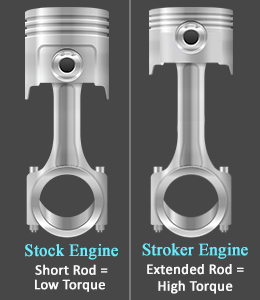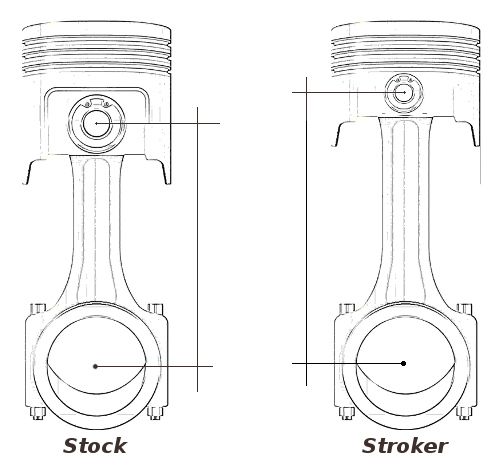
Bored and StrokedDisplacement is calculated using the bore and stroke of an engine. A better bore (cylinder diameter) leads to increased horsepower. On the other hand, a better stroke produces more torque.Before moving towards the aspect of a stroker engine, it’s essential to understand the functioning of an engine as a whole. A typical car engine has around 350 moving parts, some of the most important ones include, the crankshaft, cylinders, pistons, fuel jets, and spark plugs. In a regular four-cylinder four-stroke engine, there are four pistons, each of which completes a cycle of four separate strokes. A stroke refers to the motion of a piston across the full length of the cylinder in either direction.
Let’s see how a single piston functions in its respective cylinder of a petrol engine. A stroke begins with the piston being at top dead center of the cylinder. It then descends creating volume as a mixture of gasoline and air enter the cylinder through the intake valve. In the next stroke, the piston elevates from bottom dead center to its primary position while it compresses the gasoline-air mixture in the cylinder head. In the third stroke, when the piston is at the top, the spark plug ignites the compressed gas resulting in immense pressure forcing the piston back down. Finally, the combusted material from the burnt gas escapes via another valve as the piston returns back to the top dead center. This completes a cycle.
In this way, all the four pistons function to keep the engine powered up and roaring. But, how is a stroker engine different from a regular engine? Let’s find out.
What is a Stroker Engine?
➔ A stroker engine simply aims at increasing the engine’s stroke, or the distance covered by the piston. The logic behind this is, more distance covered by the piston would lead to faster rotating of the crankshaft, the connecting rod, this will generate better torque and obviously improve acceleration resulting in the faster rotation of the wheels of a vehicle.
➔ If a car’s torque is comparatively higher, it would surely attain its top speed in lesser time. But, don’t be fooled into thinking that the top speed/power would improve. For instance, consider two cars, a Plymouth with a torque of 204 nm at 4000 rpm, and power of 180 bhp at 6000 rpm; the second one being a ford with a torque of 163 nm at 6000 rpm, and power of 195 bhp at 8000 rpm. In a drag race, the Plymouth would clearly take the lead due to its superior torque. However, once the Ford hits 8000 rpm, it would definitely catch up with the Plymouth and even beat it.
Stroking a Stock Engine
➔ As discussed earlier, stroke refers to the distance covered by a piston from the top dead center to bottom dead center of the cylinder. Stroking basically means increasing the piston’s distance covered. Let’s see some of the ways to achieve this. A little expensive alternative can be increasing the height of the block deck, or the cavity in which the cylinders are contained. This can be done by purchasing aftermarket block decks customized for stroker engines.
➔ The second way is to extend the length of the rod connected to the piston, this would enable the piston to rotate across a larger diameter. However, simply increasing the rod length would cause it collide with the cylinder head. To avoid this, special aftermarket pistons are available, which feature the extended rod connected higher within the piston itself. Take a look at the image given below to get a better idea.

Notice the connecting rod extended higher within the piston in the image on the right.
➔ The third and final way is to purchase a stroker kit from an aftermarket store. Some stores even assist in the assembling of the kit. Stroker kits usually comprise a crankshaft, connecting rods, pistons, piston pins and rings, main bearings and rod bearings.
Stroker Engine Pros and Cons
✔ A stroked engine offers better displacement and also produces more torque easily.
✔ Time to attain top speed is reduced considerably with a stroked crank.
✔ In stroked engine cars, drivers don’t need to down shift when accelerating from lower speeds.
✖ Increasing the stroke actually makes the piston work more without any extension in time. This means the piston has to move a longer distance in the same amount of time required for shorter lengths. This would increase the piston speed causing them to wear more quickly.
✖ Over-stroking the engine can decrease its ability to retain better performance at high rpm. Also, this would lead to over-spinning of the tires, causing the vehicle to drift more resulting in quicker wearing of tires.